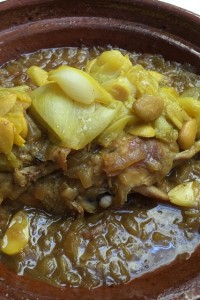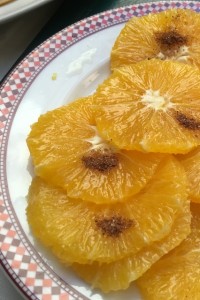‘Five star Michelin and no diarrhoea’ shouts the enthusiastic tout in Jemma al Fnad square in Marrakesh trying to out-yell his competitors to entice customers to eat in his stall. Its a crazy scene, everyone seems to be leaping around trying to sell somebody something….the square is relatively quiet during the day but by sunset it springs into a frenzy of activity, snake charmers  play their tunes and wrap snakes around the necks of hapless tourists. Women grab your hand in a vice like grip to entice you to have a henna tattoo painted on. Toy sellers stuff little drums into children’s hands as though it was a gift and then demand money when you try to prize it out of the confused child’s hands. NO is a word no one appears to understand or certainly ignores with a beaming smile.
On the left of the square, a row of colourful carts sell freshly squeezed orange juice for 4 dirhams a shot, but you need to be cautious, it can be diluted with tap water which can certainly result in the aforementioned affliction.
Belly dancers gyrate to a rhythmic beat, everyone is on the make and the energy level is off the scale. Row after row of stalls sell offal and sheep’s head soup.  Harira, the thick soup which Moroccans eat at sunset to break their fast during Ramadan is another popular offering. Snail sellers pass bowls of steaming molluscs in broth  to adventurous diners, I don’t love it, I prefer my sails smothered in garlic and parsley butter in the French tradition. We eventually relented and sat at one of the oilcloth covered tables to enter into the banter, lots of little dishes of mezze arrived, aubergine purée, harissa, fresh tomato purée, Moroccan salad and a basket of the flat bread. This was followed by Moroccan fish and chips, crispy little sole, squid and chunks of an eel like fish with lots of chips. It was all perfectly edible but not exactly a gastronomic experience. I also love the spicy merquez sausages stuffed into a roll and of course, Mechoi, the meltingly tender slow cooked, milk fed lamb that’s  served on a sheet of brown paper with salt and cumin. Seek out Meschoi Alley on the east side of the medina, Here, you can also order a tangia, a earthenware pot with a stew inside. This is a fascinating tradition, which has endured over many centuries, a poor person would own just one earthenware pot, shaped a bit like a jug without a handle or spout, they would walk around the market from stall to stall, getting a few bits of veg at one, small scraps of meat at another, a glut of olive oil , a few spices many a pinch of saffron, a bit of seasoning and then the pot would be covered with greaseproof and secured with string, this was buried in the embers at the Hamman and cooked slowly to melting tenderness.
The flavour is absolutely delicious. There are few really exciting restaurants in Marrakech perhaps with the exception of Al Fassia, a restaurant run entirely by women. The food is close to home cooking where unquestionably the best food in Morocca is to be found. Absolutely everything we ate there was delicious. We were a big family group so we had the opportunity to taste many dishes on their menu, in fact our lunch was so good that I returned for dinner. The mezze of 15 little salad dishes was superb and the pigeon bistylla in flakey, home made warka was worth travelling to Marrakech specially for. There was a choice of seven tagines, some sweet and others savoury. The chicken with lemon and green olives of course, another with shallots and almonds, We also tried two sweet ones, one with caramelised onions and raisins and another lamb tagine with tomato jam. Yet another with caramelized pumpkin. There were several others, I  particularly remember a lentil tagine and a wonderful vegetarian version.  Delicious date icecream for dessert and refreshing orange slices sprinkled with cinnamon and sugar were perfect after a rich tagine or cous cous. There were also Moroccan pastries of which there is a bewildering selection, but at Al Fassia they serve just one simple biscuit, delicious to dunk in mint tea.
Moroccan Harira Soup
In Morocco this soup is served as an important part of the festivities of Ramadan. It’s the traditional soup to break the fast. My brother Rory O’Connell shared this particularly delicious version with us and everyone loves it.
Serves 6-8
110g (4oz) dried chickpeas, soaked overnight and drained
110g (4oz) Puy lentils
450g (1lb) leg or shoulder of lamb, diced into 7mm (1/3 inch) cubes
175g (6oz) onion, chopped
1 teaspoon turmeric
1/2 teaspoon ground cinnamon
1/4 teaspoon each ground ginger, saffron strands and paprika
salt and freshly ground pepper
50g (2oz/1/2 stick) butter
110g (4oz) long grain rice
4 large ripe tomatoes, skinned, seeded and chopped
2 tablespoons (2 1/2 American tablespoons) chopped fresh coriander
4 tablespoons (5 American tablespoons) chopped flat leaf parsley
lemon quarters, to serve
Tip the chickpeas and lentils into a large saucepan. Add the lamb, onion, turmeric, cinnamon, ginger, saffron strands and paprika, then pour in 1.5 litres (2 1/2 pints/6 1/4 cups) water. Season with salt and freshly ground pepper.
Bring to the boil, skimming all the froth from the surface as the water begins to bubble, then stir in half the butter. Turn down the heat and simmer the soup, covered, for 1 1/2 – 2 hours until the chickpeas are tender, adding a little more water from time to time as necessary – it can take up to 900ml (1 1/2 pints/3 3/4 cups ) more water or stock, it should be soupy in texture.
Towards the end of the cooking time, prepare the rice. Bring 850ml (scant 1 1/2 pints/3 1/4 cups) water to the boil in a saucepan, sprinkle in the rice, the rest of the butter and salt to taste. Cook until the rice is tender. Drain, reserving 3 tablespoons of the liquid.
To Finish
Cook the chopped tomato in the reserved rice cooking water, seasoning it with salt, pepper and sugar. It should take about 5 minutes or until the tomato is “meltedâ€. Add this and the drained rice to the pot and simmer for a further 5 minutes to allow the flavours to mix. Correct seasoning with salt and pepper and perhaps a pinch of salt. Add the chopped herbs, stir once or twice and serve accompanied by lemon quarters.
Tagine of Chicken with Green Olives and Preserved Lemon
Probably the best known and best loved of all Moroccan tagines
Â
Serves 6
1 free range and organic chicken, jointed
2 onions chopped
2 tablespoons flat leaf parsley, chopped
2 tablespoons coriander leaves
1 small cinnamon stick
½ preserved lemon, cut into dice (optional, depending on size, leave whole)
175g (6oz) green olives, rinsed and stoned
Juice of 1/2 lemon
Marinade:
2 cloves garlic, finely chopped
Pinch of saffron strands
1/2 teaspoon grated ginger
1/2 teaspoon freshly ground cumin, toasted and ground
1/2 teaspoon paprika
1/2 teaspoon salt
1/4 teaspoon freshly ground black pepper
3 tablespoons extra virgin olive oil
Coriander leaves
Cous cous
First prepare the marinade. Mix the garlic, saffron, ginger, cumin, paprika, salt, freshly ground pepper and the olive oil in a bowl.  Spread over the chicken, transfer the meat to a shallow dish, cover with clingfilm and leave overnight to marinate in the fridge.
Next day, transfer the chicken and the marinade to a casserole. Add the onions, parsley, coriander and cinnamon stick and half cover with water. Bring to the boil, cover and simmer gently for about 30 minutes, turning the chicken pieces frequently in the liquid. Add more water if it starts to reduce. Cook for a further 15 minutes, partly covered, until the chicken is tender and almost falls from the bone. Add half the preserved lemon and the olives and continue cooking for a further 5-6 minutes so the flavours combine.
Transfer the chicken pieces, lemon and olives to a serving dish and cover to keep warm. Remove and discard the cinnamon stick. Reduce the sauce uncovered until it is about 250ml (9fl oz). Add the lemon juice and season to taste with more salt and freshly ground pepper.
Pour the sauce over the chicken and serve immediately with lots of fresh coriander and cous cous.
Orange Salad with Cinnamon and Orange Water Blossom
This is a classic dessert in Moroccan restaurants. The combination is a perfect palate cleanser after a rich tagine or cous cous. One could also add a few fat deglet noor dates.
Serves 6
6 large oranges
4 teaspoons orange blossom water
4-6 teaspoons caster sugar
1 teaspoon freshly ground cinnamon
3-4 sprigs fresh mint
Peel the oranges and remove the pith with a sharp knife. Slice the oranges across the equator, flick out the pips and arrange the rounds, slightly overlapping on a circular plate. Dot with cinnamon and caster sugar and drizzle with orange blossom water. Chill well before serving with shredded fresh mint or mint sprigs sprinkled over the top.
Maronchinos – Claudia Roden’s Soft Almond Cookies
Makes about 30
400 g ground almonds
125-200g superfine sugar
2 or 3 drops of almond extract
2 tablespoons rose water
2 egg whites, lightly beaten
Icing sugar to sprinkle on
Mix the almonds and sugar. Add the extract, rose water, and egg whites and work to a smooth paste with your hand. Role into walnut- sized balls, flatten them slightly, and place in little paper cases or on greaseproof or parchment paper on a baking sheet. Bake in a preheated 180°C/350°F/Gas Mark 4 oven for 25 minutes. Let them cool before dusting with icing sugar.
Cork Whiskey Festival
Don’t miss the first Cork Whiskey Festival. It runs from Thursday 14th – Sunday 17th April and  will take place  in various restaurants and pubs in Cork city. There will be lots of exciting whiskey tastings and talks. Restaurants will offer whiskey and  food pairings on their menus.  www.tastecork.com for the details
West Waterford Food Festival
Date for the diary:- once again the West Waterford Festival of Food is choc a bloc with walks, talks, demos, dinners, workshops and masterclasses from 15th-17th April – ww.westwaterfordfestivaloffood.com
Â
Wild Garlic is in full season at present, both the broad leaved ramps or ramsons, (allium ursinum) and the allium triquetrum which grow along the edges of the roads and looks like white bluebells. The flowers are delicious scattered over salads and savoury plates. The wide leaves of ramps are also delicious in salads and wild garlic pesto but this woodland plant doesn’t flower until later and has a distinctive ‘pom pom’ flower – also edible of course. Make the most of both while in season.




